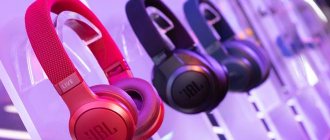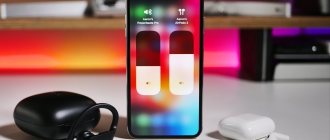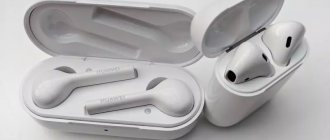Headphones have long been a part of our lives. And if 20 years ago these were bulky devices with low sound quality, now technology has stepped far forward, giving us compact Bluetooth headsets with wide functionality. Today we will discuss which headphones are better - wired or wireless, and compare their characteristics.
Features of wired and wireless headphones
The main feature of a wireless connection is the ability to transmit sound waves not through a cable, but through an analog or digital signal. For this, a Bluetooth module is often used, because it is supported by most smartphones and laptops. Due to the absence of wires, these headphones are more comfortable and durable. You can take them with you to your workout without worrying about the cable getting tangled. However, they sound worse when compared to their wired counterparts. Wired headphones are less convenient than Bluetooth devices, but have better performance and lower cost. During direct transmission, audio is not re-encoded and retains its original quality. Of course, the presence of a wire cannot completely eliminate distortion, but it significantly reduces it.
Selection by design features
Those who want to not be separated from their favorite music even for a minute and who are active will be interested in folding models. Such devices are compactly assembled and do not take up much space.
If a person cannot imagine his life without a mobile phone, his choice should fall on on-ear headphones with a microphone. This turns them into a full-fledged headset, especially since most modern smartphones are equipped with powerful sound devices that allow you to fully reveal the depth of the reproduced composition.
You should pay attention to sound insulation, as this is one of the weakest points of on-ear headphones. The presence of ear pads with a seal in such devices can minimize this drawback.
The wide range and variety of gadgets with countless options for design features and designs makes it possible to choose the right headphones for people of any lifestyle and based on any requirements.
Technical characteristics of wired and wireless headphones
When choosing wired or wireless headphones, you need to have at least a general idea of the technical characteristics. Sound quality depends on indicators such as frequency range, impedance, sensitivity, power and distortion percentage. Let's look at them in more detail:
frequency range
Frequency range is the range of frequencies that headphones are capable of reproducing. The wider it is, the better and more detailed the sound. The standard value is from 20 to 20,000 Hz, but there are devices whose range exceeds 100,000 Hz. Manufacturers often inflate indicators to attract buyers. When measuring, only the presence of a certain frequency is indicated, and not its volume. Therefore, it is better to focus on the frequency response, if available.
Impedance
Impedance is an important indicator that affects the quality of reproduced sound and electricity consumption. It largely determines the compatibility of headphones with a smartphone or player. Any device has a conditionally supported range of loads. For portable equipment, headphones with an impedance from 16 to 32 Ohms are suitable. Accordingly, for professional audio amplifiers this figure will be higher.
Sensitivity
The sensitivity determines how loud the device can play music. The standard indicator for modern models is from 90 to 120 dB, but there are also quieter ones. The higher the sensitivity, the louder the sound and the less load on the player (built-in amplifier). They also like to overestimate this characteristic. Typically, the cheaper the headphones, the quieter they play.
Power
Headphone power is indicated in watts. It affects the quality and volume of sound. The more watts, the faster the smartphone or player will discharge. It is better to choose devices with medium power if you do not plan to use an additional amplifier.
Distortion
Distortion is indicated as a percentage. It is influenced by many factors, including the characteristics of the built-in amplifier in the player or smartphone. The lower the distortion percentage, the higher the playback quality. Good headphones have 1-2% distortion.
Models with the same technical characteristics may sound different. Modern measuring devices cannot yet perceive sound in a comprehensive manner, as a person does. Therefore, before buying headphones, you need to independently evaluate their quality in the store.
Select by sound characteristics
If possible, it is advisable to choose gadgets together with the device with which you intend to use them. Music players are made on the basis of many amplifiers and have different playback patterns, so the best option would be to choose “by ear”. This way you can choose headphones that have the most acceptable sound, especially since each person’s hearing perception is individual.
What to do if the purchase is made via the Internet, or for some other reason it is impossible to independently evaluate the gadgets?
- Choose products from a well-known manufacturer with a good reputation. Sony on-ear headphones are considered one of the most acceptable solutions in terms of price-quality ratio.
- Find out recommendations for choosing on the official website of the company that produced the player.
- Listen to advice and read consumer reviews.
A marketing trick of many manufacturers is to indicate a wide range of reproducible frequencies in the product data sheet. In fact, this is not the most critical indicator, since the human ear does not distinguish frequencies beyond 20 - 2000 Hz, and even the cheapest on-ear headphones do not have such indicators.
What types of wireless headphones are there?
Wireless headphones use three main types of communication – Bluetooth, radio and infrared. All of them have their advantages and disadvantages. Now in more detail:
- Bluetooth is the most common type of wireless connection. It provides a good operating range (9-10 meters) and is suitable for all smartphones. But despite its versatility and ease of use, Bluetooth is considered to be the worst at transmitting sound. Headphones with this type of connection are suitable for everyday life or sports. They can be connected to a smartphone, laptop or TV (if the module is built-in).
- Headphones with radio communication have high sound quality and a large operating radius (up to 100 meters). But they are much more susceptible to various interferences. They often come with a bulky amplifier. They will be an excellent solution for a home theater or TV.
- The infrared port has a short range, but transmits the signal without delay. Headphones with this type of connection are not intended for use outside the home. Suitable for TV or PC at a short distance.
Should you buy Bluetooth headphones for your home? Yes, if you want to save money on a portable amplifier. The only drawback is that there may be a slight audio delay.
Capabilities of modern devices
The variety of technical solutions that developers use allows them to expand their capabilities. For example, on-ear headphones with a microphone can be used to communicate on a mobile phone.
Wireless headphones do not have connecting wires, and the sound is transmitted over a separate radio channel. Thus, the practicality and ease of working with them increases. The downside of such models is that additional power consumption is required for the transmitter and receiver of audio signals. A useful feature for wireless headphones is the auto-shutdown feature, where the power automatically turns off after a certain amount of time of inactivity.
Some manufacturers equip their gadgets with an FM tuner for listening to your favorite radio programs. In this case, they can be used as a separate device.
The most advanced models have built-in electronic filters, noise absorbers, graphic equalizers, etc. The price for them is usually much higher, so you should pay special attention when buying these on-ear headphones. Owner reviews will help determine the real benefits of such additional devices.
Advantages and disadvantages of headphones
It is difficult to immediately determine which headphones are better - wired or wireless. You need to be guided by the characteristics and functionality. We have highlighted the common advantages and disadvantages of both types:
Wireless models
Advantages:
- No wire. According to statistics, every third headphone fails precisely because of damage to the plug. Wireless models are not affected by this, because The cable at the entrance does not get pinched and does not rub against clothing.
- Ease of use. You can take wireless headphones on a run or workout without worrying about where to put your smartphone. They do not depend on the cable length and operate within a radius of 9-10 meters.
- Increased functionality. Almost all Bluetooth headphones have voice control. Some models have a built-in pedometer or heart rate monitor.
Flaws:
- Working hours. The headphones need to be charged constantly. They are not powered by a smartphone like wired devices. In addition, the battery wears out over time and requires replacement. The average operating time is from 6-8 hours.
- Sound quality. Bluetooth headphones sound worse than wired ones.
- Price. The price tag for Bluetooth devices is much higher.
Wired models
Advantages:
- High quality sound. The wire provides high precision sound transmission.
- Affordable price. Using a Bluetooth module in a design is more expensive than using a cable. Therefore, wired headphones with equal characteristics will cost less than wireless ones.
- Connection stability. The transmitted signal is not interrupted, as is often the case with Bluetooth headphones.
Flaws:
- Risk of damaging the wire. Some manufacturers use an L-shaped plug to extend the life of the device.
- Not suitable for sports. The wire restricts movement and clings to clothing.
Need for use
Before you come to a decision about whether to purchase on-ear headphones or not, it is worth delving into some of the nuances that will determine the need to use them.
The above advantages may not be present in many cheap models. Manufacturers seeking to reduce the cost of their products often sacrifice quality to achieve this. As a result, trying to save money will lead to disappointment after the purchase.
You need to understand that even the best on-ear headphones will not have good sound without a quality source. Therefore, it is not advisable to use expensive devices with cheap Chinese mp3 players.
How to choose headphones
Since the audio market is flooded with different types of headphones, choosing the right option can be quite difficult. Here are some tips:
- Working hours. Wireless headphones are powered by built-in batteries. They come in two types - Li-Ion and Ni-Cd. It is better to give preference to Li-Ion batteries, because... They are light in weight and can withstand recharging better. The operating time of the headphones largely depends on the battery capacity. It is indicated in ampere hours (mAh or mAh). The larger the capacity, the longer the battery life.
- Design. All headphones can be divided into three types: in-ear (vacuum), full-size and on-ear. For everyday wear, it is preferable to use earbuds, because... They are compact and do not put pressure on the ears. Full-size or overhead ones are suitable for home use.
- Sensitivity. The higher the sensitivity, the louder the sound. Most often you can find devices with readings from 90 to 120 dB. The volume also depends on the power of the built-in amplifier in the smartphone.
- Impedance. Any equipment has an acceptable load limit. The higher the impedance, the more powerful the amplifier must be. Don't buy high-impedance headphones for low-impact portable devices. An acceptable value is from 16 to 32 Ohms.
Selection based on the technology used
Before you buy headphones, you need to understand which ones are suitable for use. Different devices are compatible with different types of headphones. For example, full-size Bluetooth headphones are best for watching TV. Both wired and wireless headphones are suitable for listening to music at work and at home. The best wireless headphones for music can be either full-size or on-ear. Wireless ones are used in large rooms where movement is important.
Wired ones are suitable for listening to music on a computer or laptop. The closed acoustic type headset is most popular for use in the office. This is due to good sound insulation. Open-back headphones are suitable for use at home. For sports and outdoors, on-ear headphones are chosen; for transport and other public places, most often, small in-ear wired or wireless ones are chosen. Athletes are increasingly choosing bluetooth headphones.
A full-size, wrap-around headset with a long, durable cord is preferred by modern gamers. The ability to reproduce surround sound is an important criterion when choosing an accessory.
Rating of wired headphones
This rating contains the best wired headphones as of 2021-2018. Model comparisons were based on reviews and overall ratings.
Sony MDR-7506
pros
- excellent sound;
- good sound insulation;
- workmanship.
Minuses
- heavy twisted cord;
- low quality ear pads.
From 6000 ₽
Professional stereo headphones for mixing and sound processing. Features include gold-plated connectors, oxygen-free copper wires and neodymium magnets. A carrying case is included.
Beyerdynamic DT 770 Pro
pros
- volumetric stage;
- comfortable fit;
- excellent noise reduction.
Minuses
- the sound depends heavily on the amplifier;
- medium volume.
From 13000 ₽
Sennheiser Momentum 2.0 Over-Ear
pros
- detailed sound;
- convenient design;
- suitable for smartphones.
Minuses
- poor quality of replacement cable;
- require warming up.
From 11000 ₽
The headphones have convenient controls adapted for iOS devices.
Denon AH-MM400
pros
- good sound quality;
- high-quality assembly;
- Well suited for both a smartphone with a separate chip and a player.
Minuses
- lack of cable for the hospital;
- poor microphone quality.
From 20000 ₽
Fostex TH-7
pros
- good sound for the money;
- comfortable fit;
- high-quality sound insulation.
Minuses
- short wire;
- you need a good amplifier.
From 4000 ₽
What to do if vacuum headphones fall out of your ears?
Here are a few life hacks that will help you cope with this trouble:
- Carry the device with the wire facing up. Many models have a design that suggests only this way of using them. Even if you have a different option, you can wear them this way, but in some cases you have to swap the right and left earbuds.
- The reason why vacuum headphones fall out of your ears may be that the cord is too long or that it is not secured. In both cases, a special clothespin will help, with which the wire can be attached to clothing.
- The headphones fit better if the wire is thrown over the back of the neck.
- Over time, the ear tips wear out, causing them to fit unreliably in the ear canal and fall out. This is a reason to replace them.
Wireless headphones rating
The best wireless headphones as of 2021-2018.
Bose Quiet Comfort 35 II
pros
- active noise cancellation;
- good sound quality;
- It is possible to work from a cable.
Minuses
- the battery cannot be replaced;
- Sometimes they lose connection.
From 22000 ₽
Apple AirPods
pros
- active noise cancellation;
- integration with Apple devices;
- battery life.
Minuses
- poor sound insulation;
- inconvenient design.
From 14000 ₽
Marshall Major II Bluetooth
pros
- good sound quality;
- convenient control;
- You can listen to music while charging.
Minuses
- on the street the sound may stutter;
- discomfort with constant wear.
From 10000 ₽
Samsung EO-BG950 U Flex
pros
- good sound quality;
- excellent sound insulation;
- long operating time;
- convenient design.
Minuses
- poorly isolate sound;
- The connection may be lost.
From 4000 ₽
Inexpensive sports headphones with a foldable design. They have light indication and convenient Multipoint control.
Sony SBH24
pros
- comfortable shape;
- connection reliability;
- 6 hours of playback.
Minuses
- short charging cord;
- sometimes there is interference.
From 2000 ₽
Vacuum headphones - what are they?
The device is an intracanal device with a special nozzle. The name “vacuum” does not quite correspond to the principle of its operation, because it does not create low pressure or absolute tightness. The earpiece fits tightly against the walls of the ear canal, forming a closed space in which air does not circulate. There are other names for this device:
- headphones;
- in-ear headphones;
- plug-in devices.
Which headphones are better - vacuum or in-ear?
Both options have their pros and cons. Earbuds are regular headphones shaped like tablets. Choosing a model is an individual matter, and to make it easier, it is worth familiarizing yourself with the characteristics of each option in comparison according to certain criteria.
- Dimensions
. In-ear headphones are portable, compact, and lightweight. They are convenient to use on the road, while walking or jogging. In this parameter, the earbuds are not inferior to them. - Sound quality, noise isolation
. The vacuum version is immersed deep into the ear canal, thanks to which it is possible to drown out external sounds, therefore improving the sound quality. - Hearing safety
. Inserts are considered more loyal in this regard. They create less pressure in the ear canal than earplugs. In order not to provoke headaches or discomfort, you should not use vacuum headphones for several hours in a row and listen to music loudly. - Convenience
. If the size of vacuum headphones is chosen correctly, then wearing them will not cause discomfort. At the same time, many users experience inconvenience from the fact that the device falls out of their ears. The level of attachment reliability of in-ear headphones is higher than that of earbuds. - Price
. It depends on the manufacturer and quality of the headphones. Vacuum models are considered more expensive, but their cost may be lower than the price of high-quality liners with good technical characteristics.
Trends of the modern world
The trend in the modern world is towards the fact that soon it is planned to abandon the use of wires . Wireless headphones are not the first step towards achieving this result. Just a few years ago, no one could have imagined that modern headphones would work wirelessly. Therefore, every modern user should understand what to expect when purchasing such a wireless accessory.
Minuses
Despite all the listed advantages of wireless headphones, this accessory has its drawbacks, which you should know about before purchasing.
- Lower quality than traditional wired accessories.
- Weight, which is increased due to the built-in battery.
- Some phone models simply do not have such a device as Bluetooth. For this reason, their use is simply impossible.
- Another significant disadvantage is the cost. After all, high-quality wireless headphones cost a lot of money compared to conventional models.
- Another unpleasant feature of such headphones is their unexpected discharge, which can bring not only inconvenience, but also certain difficulties.
- The dimensions of the device are large, so it is not always possible to hide them in your pocket, like simple wired headphones.
Therefore, if you think about it, such shortcomings are still significant, even if the technology is progressive and promising.











